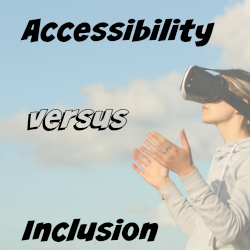
Is complete accessibility necessary for inclusion? Can anything be truly inclusive if it’s inaccessible? In this episode, we explore these questions and try to figure out where access and inclusivity intersect. A transcript for this episode can be found here. This transcript is due to our generous supporters on Patreon. Thank you.
What prompted the conversation about accessibility and inclusion?
Recently, the Washington Post published an article about an access “solution” developed for people with mobility disabilities. “Infinity Mirrors,” an exhibit at the Hirshhorn Museum and Sculpture Garden was not created in a way that’s accessible for wheelchair users. So, the Smithsonian’s Accessibility Program got to work with the Hirshhorn’s multimedia and technology team to recreate the experience of the exhibit using virtual reality (VR). The result? People unable to access the exhibit can take it in through a VR headset.
Is that really a solution for inaccessibility?
Not really. It’s an awesome use of VR, but it doesn’t solve the real issue. The exhibit itself is still not accessible for wheelchair users to experience in person. And if a wheelchair user goes to the museum with a group and has to hang back and see the exhibit with a VR headset while everyone else goes inside the actual exhibit, that’s pretty exclusionary.
But aren’t there laws requiring public places like museums to be accessible?
Yes. The Americans with Disabilities Act of 1990 (ADA) requires access to public places. Museums should be taking this into account when building new structures or installations. And the Smithsonian itself actually has Guidelines for Accessible Exhibition Design. It seems, in the case of “Infinity Mirrors,” they’re forsaking the law and their guidelines in favor of art.
Does this one museum exhibition matter on a larger scale?
It sure does. It’s an example of issues that come up over and over again. First, accessibility is still frequently an afterthought. Second, it’s often conflated with inclusion. People think that efforts to make something accessible also make it inclusive by default. But that’s definitely not the case. Access is only the first step toward inclusion.
Join us as we dive into why access and inclusion are not interchangeable and talk about the importance of making accessibility meaningful.
Notes from this episode: Robot Visits White House

